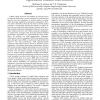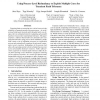105 search results - page 1 / 21 » Opportunistic Transient-Fault Detection |
ISCA
2005
IEEE
14 years 4 months ago
2005
IEEE
CMOS scaling increases susceptibility of microprocessors to transient faults. Most current proposals for transient-fault detection use full redundancy to achieve perfect coverage ...
DSN
2007
IEEE
14 years 5 months ago
2007
IEEE
Transient faults are emerging as a critical concern in the reliability of general-purpose microprocessors. As architectural trends point towards multi-threaded multi-core designs,...
DEPCOS
2007
IEEE
14 years 2 months ago
2007
IEEE
State automata are implemented in numerous ways and technologies
DSN
2007
IEEE
14 years 5 months ago
2007
IEEE
A new approach is proposed that exploits repetition inherent in programs to provide low-overhead transient fault protection in a processor. Programs repeatedly execute the same in...
ISCA
2000
IEEE
14 years 3 months ago
2000
IEEE
Smaller feature sizes, reduced voltage levels, higher transistor counts, and reduced noise margins make future generations of microprocessors increasingly prone to transient hardw...


